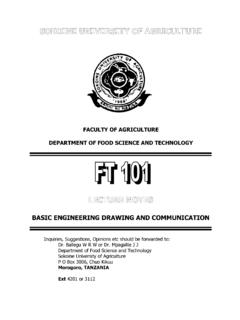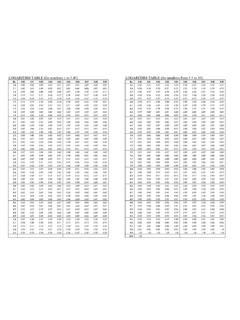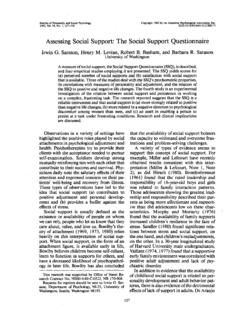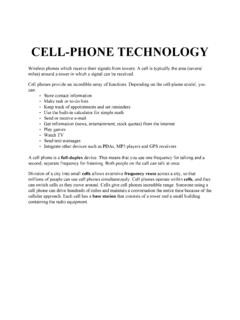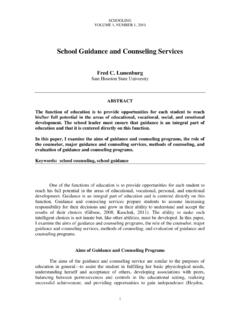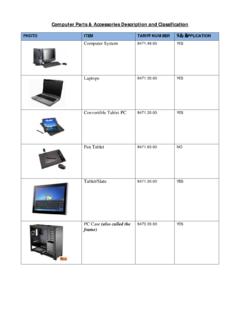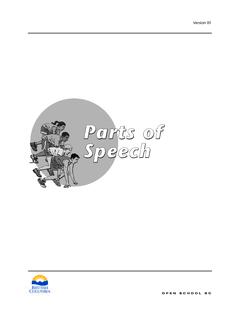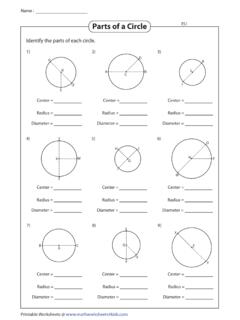Transcription of Types of Computer & Their Parts - WikiEducator
1 Types OF COMPUTERS AND Their Parts Page 1 of 6 Source: Log on to IT for CSEC by R Birbal & Michele Taylor. MULTIPLE CHOICE QUESTIONS 1. What is a Computer ? a. A programmable electronic device that processes data via instructions to output information for future use. b. Raw facts and figures that has no meaning processed via a set of instructions. c. Meaning attached to data letters, pictures, symbols or sounds. d. All of the above 2. What is Data and Information: a. Raw facts and figures that has no meaning processed via a set of instructions and Meaning attached to data letters, pictures, symbols or sounds. b. Raw information and meaningful data. c. Symbols, pictures or sounds. d. All of the above. 3. Why do users use computers? a. For Their data processing speeds, accuracy, storage capacity and ability to work for long periods.
2 B. Computers are very fast and not very accurate. c. Computers work for long periods without the need for maintenance. d. Computers stores large amounts of data. 4. A Computer system consists of both hardware and software. a. True. b. False. 5. Hardware is a set of instructions called programs the Computer uses to carry out tasks while Software are all the Parts of the Computer you can see and touch and is also known as peripherals. a. True b. False. 6. Tasks the Computer usually performs are: a. Drawing a picture, typing a letter and perform calculations. b. Word processors, spreadsheets and graphic packages. c. Hardware and software used to process data. d. All of the above. 7. To accomplish a task a Computer has to process data in three stages. They are: a. b. c. d.
3 8. The CPU is also known as: a. The Brain b. The Processor c. The Central Processing Unit d. All of the above. 9. What is a machine cycle: a. Data measured in megahertz. b. Data measured in gigahertz. c. A sequence of instructions performed to execute one program instruction. d. All of the above. Output Processing CU ALU Input Hardware Software CPU Hardware Input Processing Output Types OF COMPUTERS AND Their Parts Page 2 of 6 Source: Log on to IT for CSEC by R Birbal & Michele Taylor. 10. The speed at which the CPU processes data to convert is measured in what: a. Megahertz b. Gigahertz c. Nanoseconds d. A and B 11. Machine cycles are measured in nanoseconds a. True b. False. 12. The two smaller units of the Processor are CU and ALU. a. True b. False 13. Which smaller unit of the CPU directs and coordinates all activities within it and determines the sequence in which instructions are executed, sending instructions sequence to other smaller unit.
4 A. CU b. ALU c. PROCESSOR d. All of the above. 14. Which smaller unit of the CPU performs all arithmetic and logic functions in a Computer ? a. CU b. ALU c. PROCESSOR d. All of the above. 15. The CPU primary responsibility is the movement of data and instructions from itself to main memory and ALU and back. Arrange the CU execution of instructions in the correct order by placing the execution instructions letter in the box provided: a. Sends data to memory unit after processing. b. Fetches data required by the instruction from memory. c. Fetches the instruction from memory. d. Decode the instruction. e. Send data and instruction to the ALU for processing 16. Which smaller CPU unit contains registers temporary storage locations that holds a single instruction or data item needed immediately and frequently.
5 A. CU b. ALU c. PROCESSOR d. All of the above. 17. Program Counter (PC) and Instruction Register (IR) are examples of registers. a. True b. False 18. Which register example holds the address of the current instruction being processed? a. Program Counter. b. Instruction Register. c. Control Unit d. Arithmetic Logic Unit. Types OF COMPUTERS AND Their Parts Page 3 of 6 Source: Log on to IT for CSEC by R Birbal & Michele Taylor. 19. Which register example hold the instruction itself? a. Program Counter. b. Instruction Register. c. Control Unit d. Arithmetic Logic Unit. 20. Central Processing Unit, Input Devices, Output Devices, Main Memory, Arithmetic and Logic Unit (ALU), Control Unit (CU), Secondary or Auxilliary Storage Devices/Backing Store/Disk Storage. Use the word to complete the diagram.
6 21. Main Memory holds data and instructions being processed by the Computer and is this memory is directly accessible by the CPU. a. True b. False. 22. It is difficult to classify Computer systems on the basis of Their system performance, as newer, smaller Computer systems outperform Their larger models of yesteryear. a. True b. False. 23. The different Types of Computer are: a. Personal Computers (PCs), Laptops and Minicomputers b. Mainframes, Supercomputers and Tablet PC c. Electronic Organizers and Palmtop Computers and Embedded Computers d. ALL OF THE ABOVE. 24. Label the different Types of Computers using: Supercomputer, Minicomputers, Mainframes, Tablet PC, Electronic Organizers, Palmtop Computers, Embedded Computers, Personal Computers, Laptops, Notebooks, Sub-notebooks.
7 */ * used for number crunching scientific simulations, research and developments in energy, space exploration, medicine and industry. * designed to process complex scientific applications. * are the most expensive computers in the world costing millions of dollars Page 4 of 6 Source: Log on to IT for CSEC by R Birbal & Michele Taylor. Types OF COMPUTERS AND Their Source: Log on to IT for CSEC by R Birbal & Michele Taylor. Personal Computer also known as:C * comes in different size, shapes * used by one person at a time. * consists of Monitor, System Unit, Mouse, Keyboard. * designed to perform input, control, arithmetic/logic, output and storage functions * executes software program instructionsvariety of tasks.
8 Portable version of PC with flat LCD monitor. Weighs 1-4 kilograms. There are two Types : Notebooks and SubNotebooks. Notebook: weighs 2 Is roughly the size of a 25 * 4 cm) Touch sensitive pad serves as mouse. Tucked in briefcases. Gets its power from electrical outlet or rechargeable batteries Just as powerful as PCs but cost more. Sub-Notebooks: weighs1/2 kilogr Fits in a large jacket pocket. Small colour screen, keyboard without mouse function. Performs many function of notebooks to a lesser degree Looks like a notebook Data is entered via keyboard, touch screen or digitizing tablet with a stylus Fits in the palm of your hand Less powerful than Notebooks & sub Weighs 300 grams on average. Small keyboard, palm size screen with special pen. More powerful than electronic organizers.
9 Used mainly to store appointments, addresses, and telephone numbers and to do lists . Types OF COMPUTERS AND Their Parts Personal Computer also known as: omes in different size, shapes and colours. * used by one person at a time. * consists of Monitor, System Unit, Mouse, Keyboard. * designed to perform input, control, arithmetic/logic, output and storage functions. * executes software program instructions to perform a wide Portable version of PC with flat LCD monitor. 4 kilograms. There are two Types : Notebooks and Sub-weighs 2-4 kilogram. Is roughly the size of a thick large notebook (35 * Touch sensitive pad serves as mouse. Tucked in briefcases. Gets its power from electrical outlet or rechargeable batteries Just as powerful as PCs but cost more. weighs1/2 kilogram.)
10 Fits in a large jacket pocket. Small colour screen, keyboard without mouse Performs many function of notebooks to a lesser Looks like a notebook. Data is entered via keyboard, touch screen or digitizing tablet with a special pen called a Fits in the palm of your hand, shirt pocket. Less powerful than Notebooks & sub-notebooks. Weighs 300 grams on average. Small keyboard, palm size screen with special More powerful than electronic organizers. Used mainly to store appointments, addresses, and telephone numbers and to do lists . Page 5 of 6 Source: Log on to IT for CSEC by R Birbal & Michele Taylor. 25. Computers are classified broadly into five generations based on the electronic component used to build them. Label the generation, its main characteristic, computers built in list the component used to build its computers and the software used to programs it from the list below: First Generation (19451 and Generationcomputers, assembly language, IBM 1400 & 1600 and UNIVAC Generation (1964reliable computersFourth Generation (1971capabilities, IBM system 3090 and RISC Generation (present parallel processing, performs multiple simultaneous operations using a single microprocessor chip Types OF COMPUTERS AND Their Source: Log on to IT for CSEC by R Birbal & Michele Taylor.))))
